Killed in the Line of Duty……….
“Beckenham was an extremely dangerous place to be during the Blitz, as it was “Bomb Alley” directly under the flight path of the German planes on their way to attack London. Surprisingly, though, the great majority of the men were not killed on home ground, but in London. This is the tale of one such fireman.
George John Joseph Hall was born 15th October 1910 in Gillingham, the son of George Hall, a civil servant with the Ministry of Labour, and Annie Bessie Kemp.
My mother was married twice and widowed twice. My father was her second husband. This is the story of her first husband, George John Joseph Hall and their very brief marriage during World War II.
Not sure when or how my mother, Ethel Beatrice Jackson, met George John Joseph Hall, her future husband, one never thinks to ask until it is too late. When they met, George had a well-paid job as an electrician working for a glass manufacturer and was living at 44 Warwick Road, Anerley, with his parents who had come from Bermondsey. Ethel was living with her parents in Beckenham nearby.
However, one day George arrived at work to find the workplace locked and his employer sitting on the steps outside crying. He was a German Jew and had been told by the authorities that he was to be interned. Internment tribunals were set up as soon as war was declared and many “aliens” were interned by early 1940 when the threat of invasion was thought imminent.
So George had to find another job and joined the Auxiliary Fire Service that had been formed in 1938 to assist the established fire service in the event of war. Originally recruits were unpaid volunteers, but by the time George joined, he was full time and was paid £3 a week. Women received £2 and worked as drivers or in fire stations doing office work. Youths under 18 received £1 and became messengers equipped with motor or pedal cycles.
At first AFS recruits endured poor accommodation, inadequate conditions and were dubbed “£3-a-week war dodgers” by the public who thought they were trying for an easy life. So many resigned to join the forces or do other war work that the government passed a statutory order preventing full-time members from resigning. Once the blitz began, attitudes towards them changed and they received the recognition they deserved and were sometimes bought rounds in a pub.
The book “UNDER FIRE The Blitz Remembered” explains the organisation:
“Apart from the LFB, there were no fewer than 66 smaller brigades in the Greater London Region, some of which had only one pump to protect a small territory. They were organised into five districts and placed under the control of the Chief Officers of Ealing, Tottenham, West Ham, Beckenham and Croydon. For each regular fire station area, an average of six sub-stations were set up, staffed by the AFS, with a regular Sub-Officer in charge.”
The photos show George and his colleagues proudly standing beside their fire fighting equipment – an AFS trailer pump with a towing unit painted a dull grey. They would have received 60 hours training by a regular fireman. London taxis were also used to tow pumps.
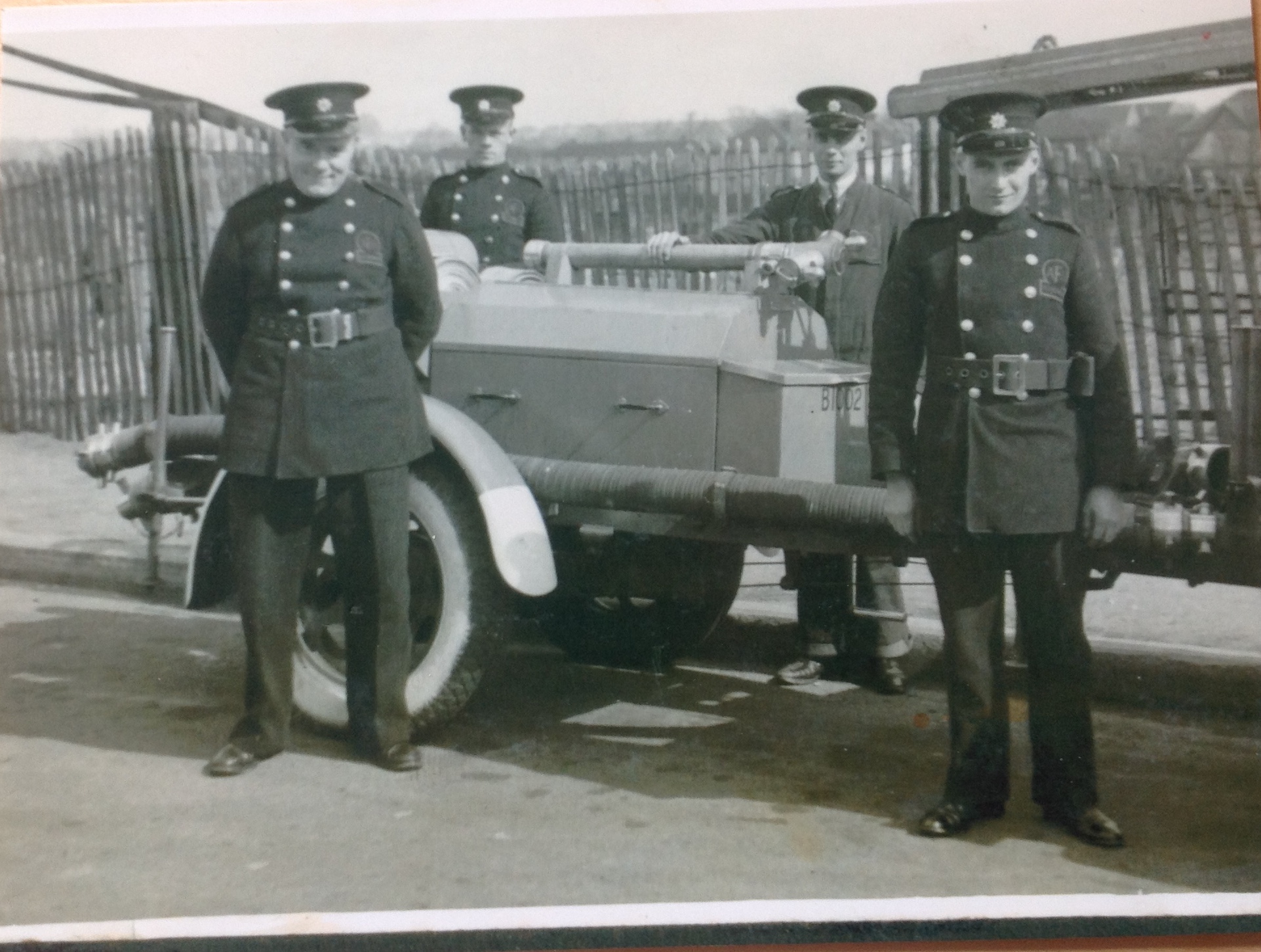
(George Hall on the far left with his colleagues)
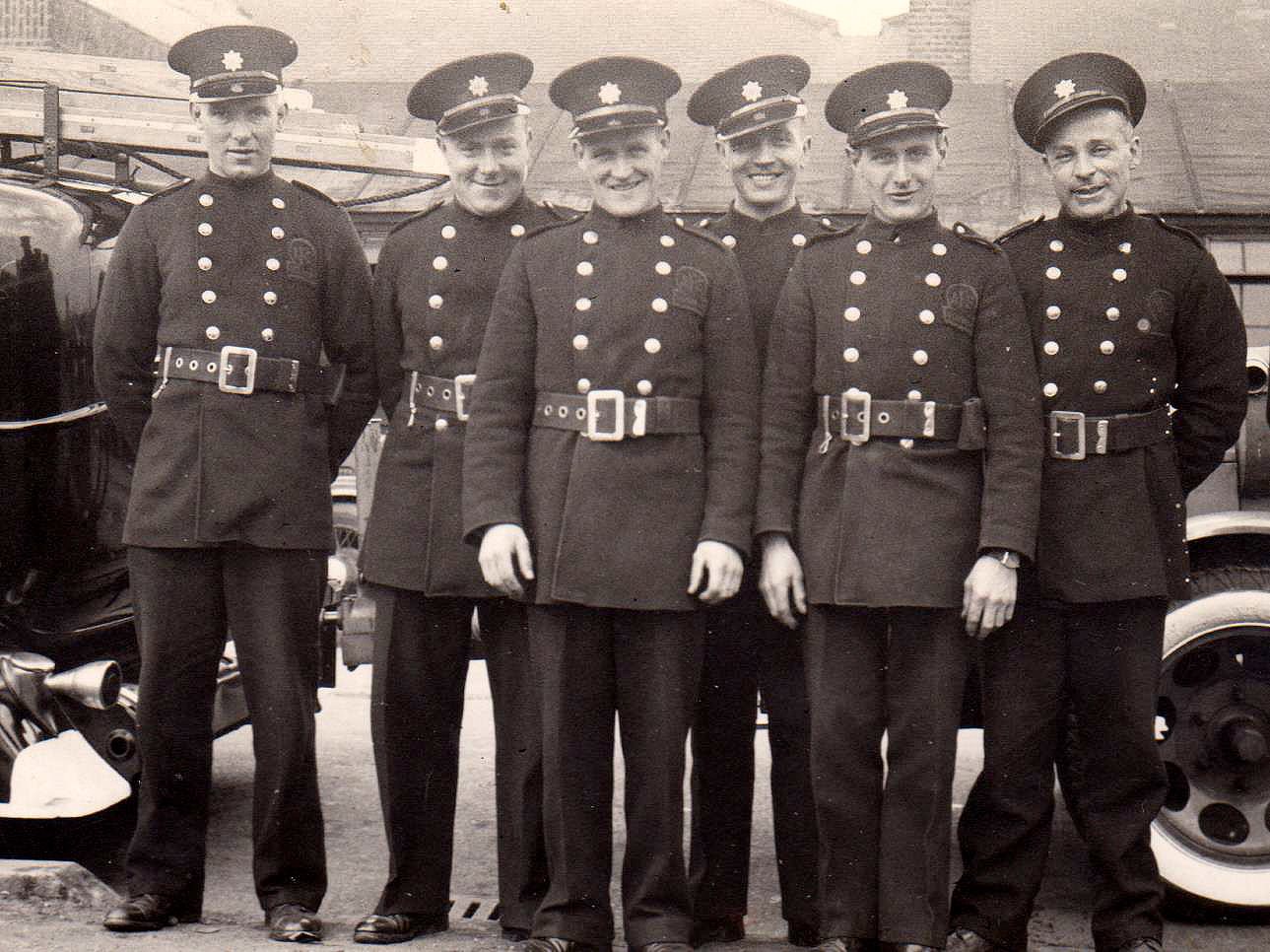
(George Hall, second left with his colleagues)
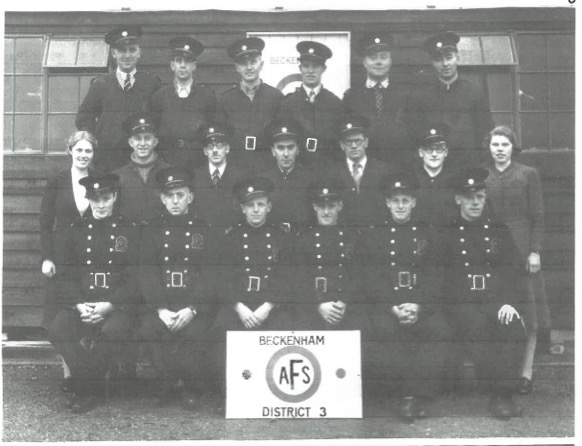
(George Hall, back row second from right)
But life went on and on 21st July 1940 George and Ethel were married at Beckenham Congregational Church, Crescent Road witnessed by delighted family and friends. When they emerged from the Church, they walked through a guard of honour formed of more than 16 of George’s fellow firemen in uniform and with raised axes. They were followed by the four adult bridesmaids, my mother’s three sisters and her new sister-in-law.
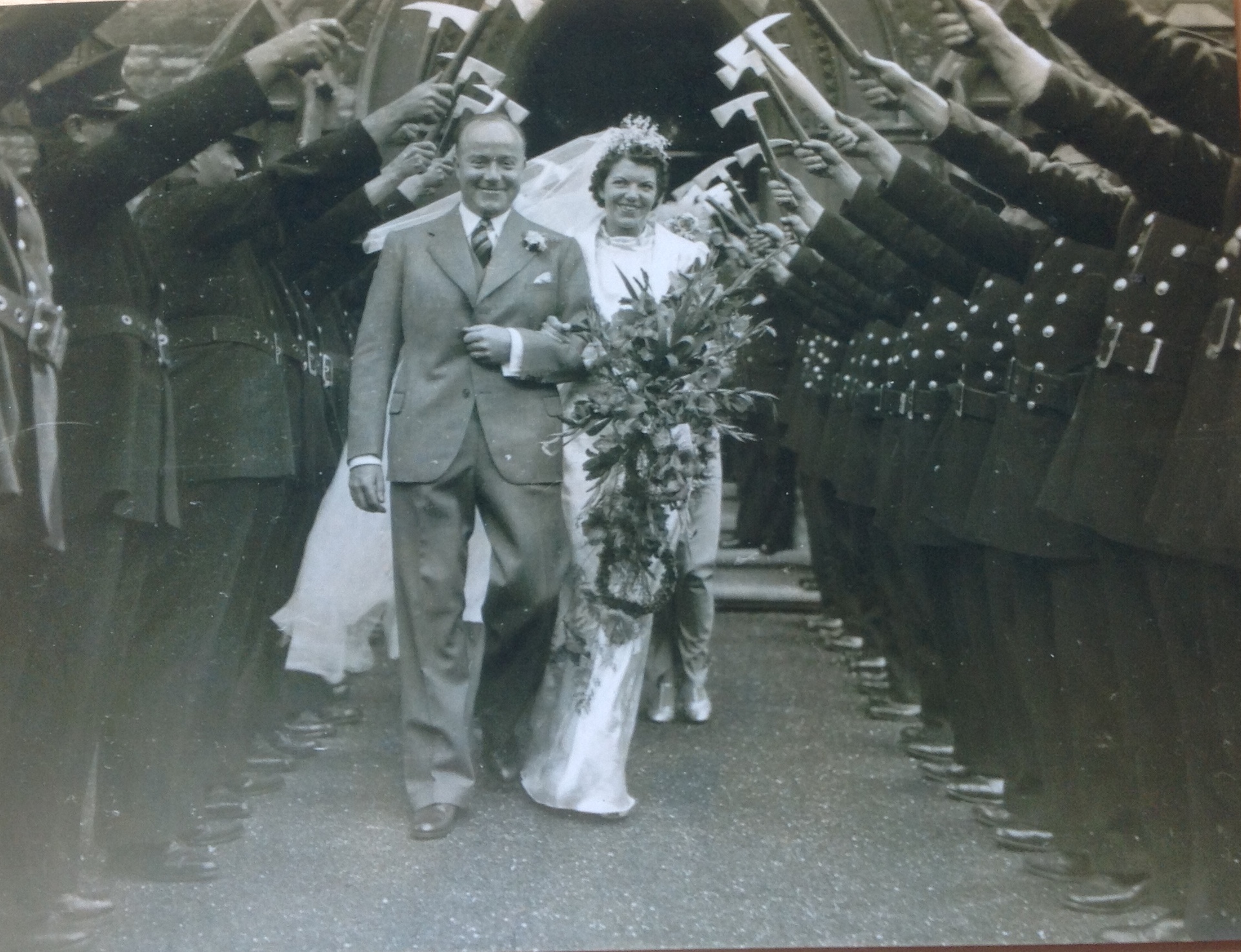
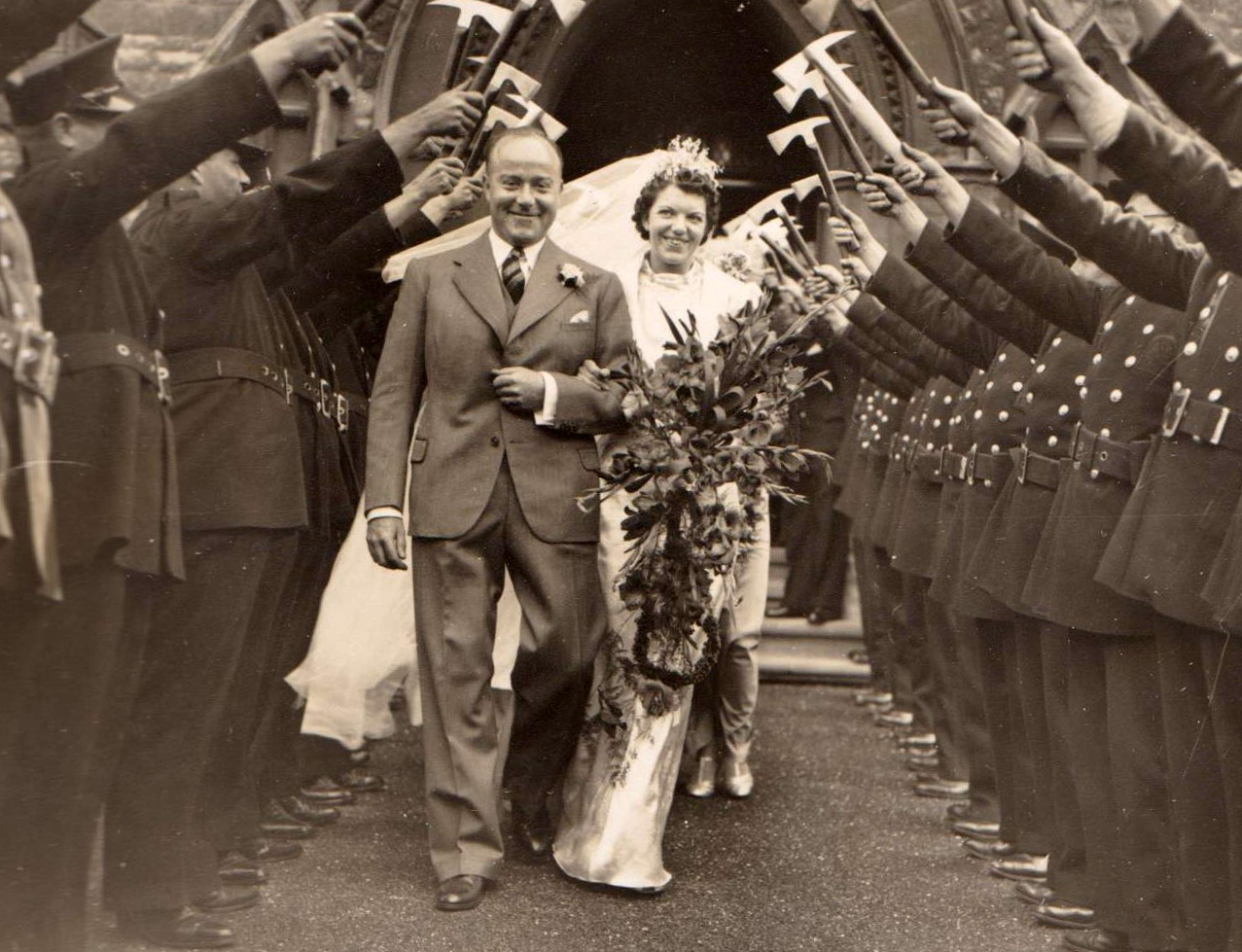
(The Marriage of George Hall and Ethel Jackson)
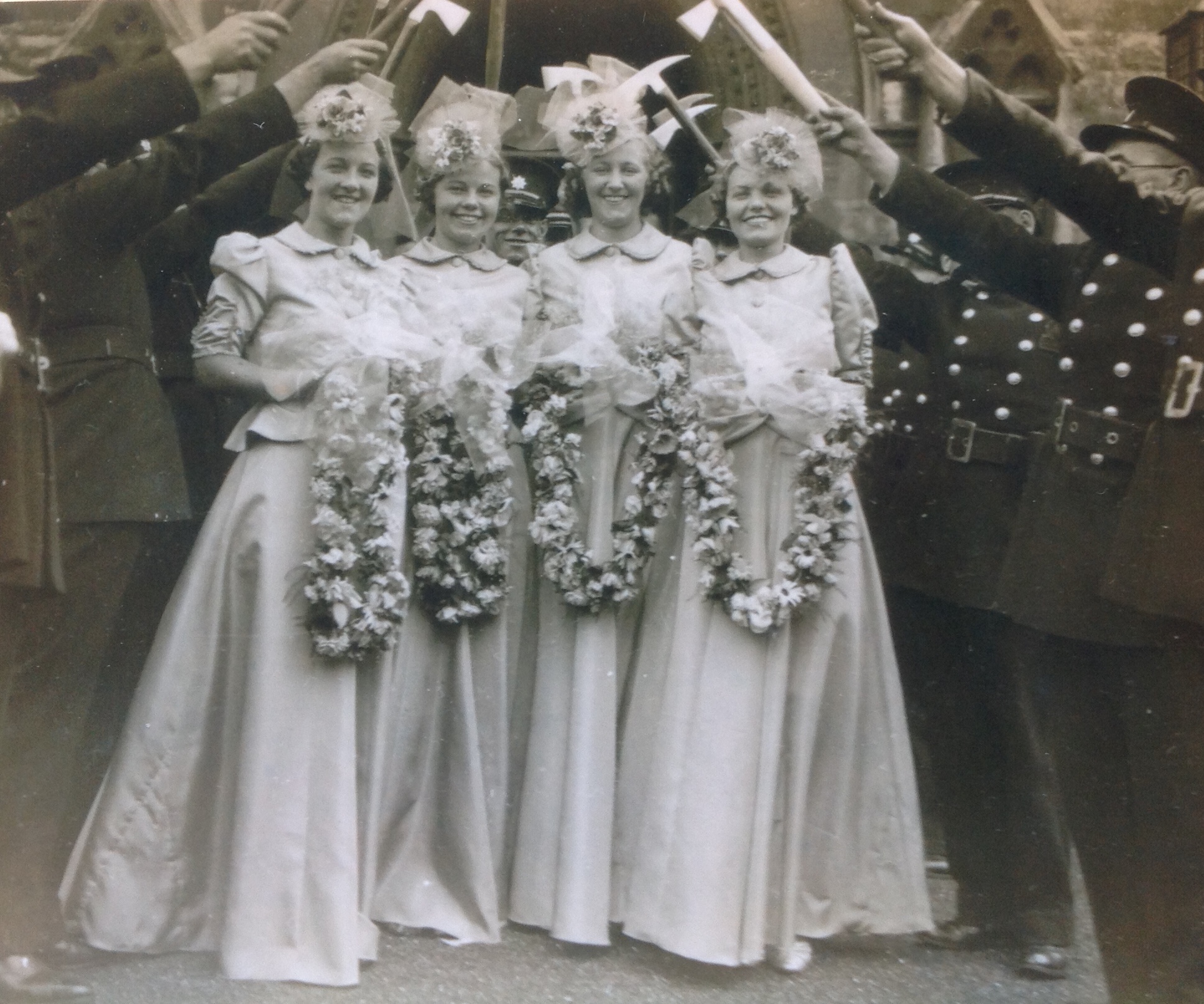
(The Bridesmaids)
I would like to add a fashion note here. The bridesmaid’s dresses were each a different colour and were intended to be used afterwards as evening wear, hence the jackets so they would be suitably modest to wear in church. My mother made all the dresses, including her own. Afterwards, she dyed her gown pale blue, but I doubt she ever had the occasion to wear it again. It finally made an appearance in my dressing up box.
Mum went to live with George and his parents at 44 Warwick Road, Anerley, which was in walking distance of her parents and other relatives. George and his colleagues continued to fight fires and damage locally and in London.
On the night of 19/20th April 1941, London suffered its heaviest single wartime attack when over 1000 tonnes of high explosives and 153,096 incendiaries were dropped on an area stretching from Tower Bridge to Woolwich.
With local London fire crews fully occupied, four AFS crews from Beckenham were dispatched to Old Palace School, Poplar to stand by. The pupils had been evacuated and the school was now a sub-station with garages, stores, offices and dormitories.
The 21 firefighters arrived at the fire station at 1.30 in the morning and mustered for orders alongside crews from Bow and Homerton – making a total of 34
Twenty-three minutes later at 1.53 am, the school received a direct hit from a bomb which demolished part of the building and started a major fire throughout the rest.
All 32 firemen and two firewomen at the school died. The entire building was demolished. This was the largest number of fire fighting personnel lost in a single incident in English history of Britain’s fire service. The oldest two were 46, most were in their twenties and thirties and the youngest was a 17-year-old messenger, Bertie James Harris, too young to do the perilous job of fire fighting, but nevertheless exposed to their danger. Also, two women died: Hilda Dupree aged 21 and Winifred Peters, a mother of three.
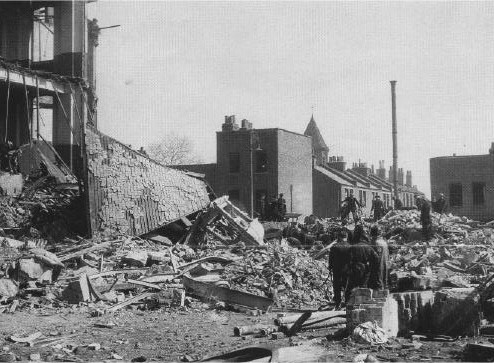
(Surveying the devastation)

(Searching for bodies)
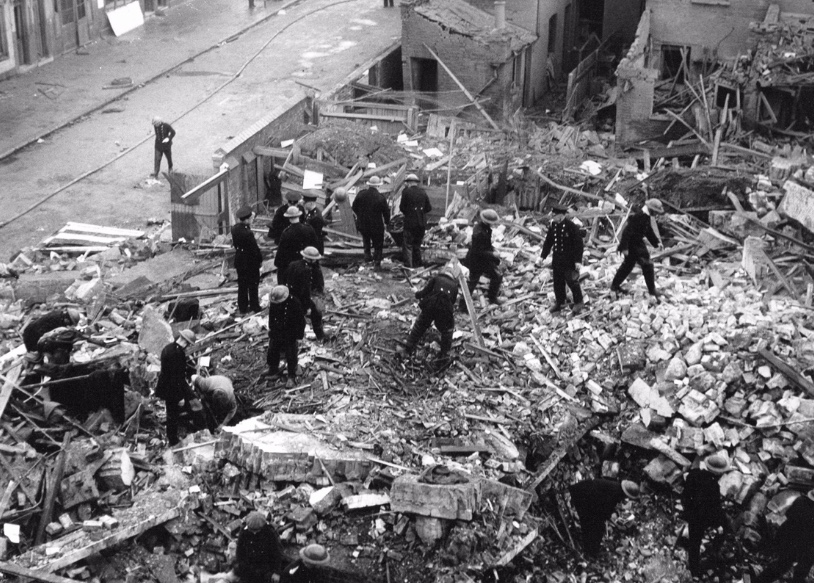
(The search continues)
It was three days before George’s death was confirmed to my mother.
The night before the funeral, the coffins were placed in St George’s Church Beckenham and guarded by firemen. On 25th April, 19 of the Beckenham firemen were buried in a mass grave at the Elmers End cemetery after a memorial service at the parish of St George and a solemn procession through the town.

(The Guarding of the Coffins)
The coffins were carried in hearses, preceded by two fire engines that were covered in wreaths and daffodils. It took half an hour for the procession to pass at any point on the route, so many uniformed officers followed the coffins. I think my mother confirmed that most of the guards of honour at her wedding were buried that day.
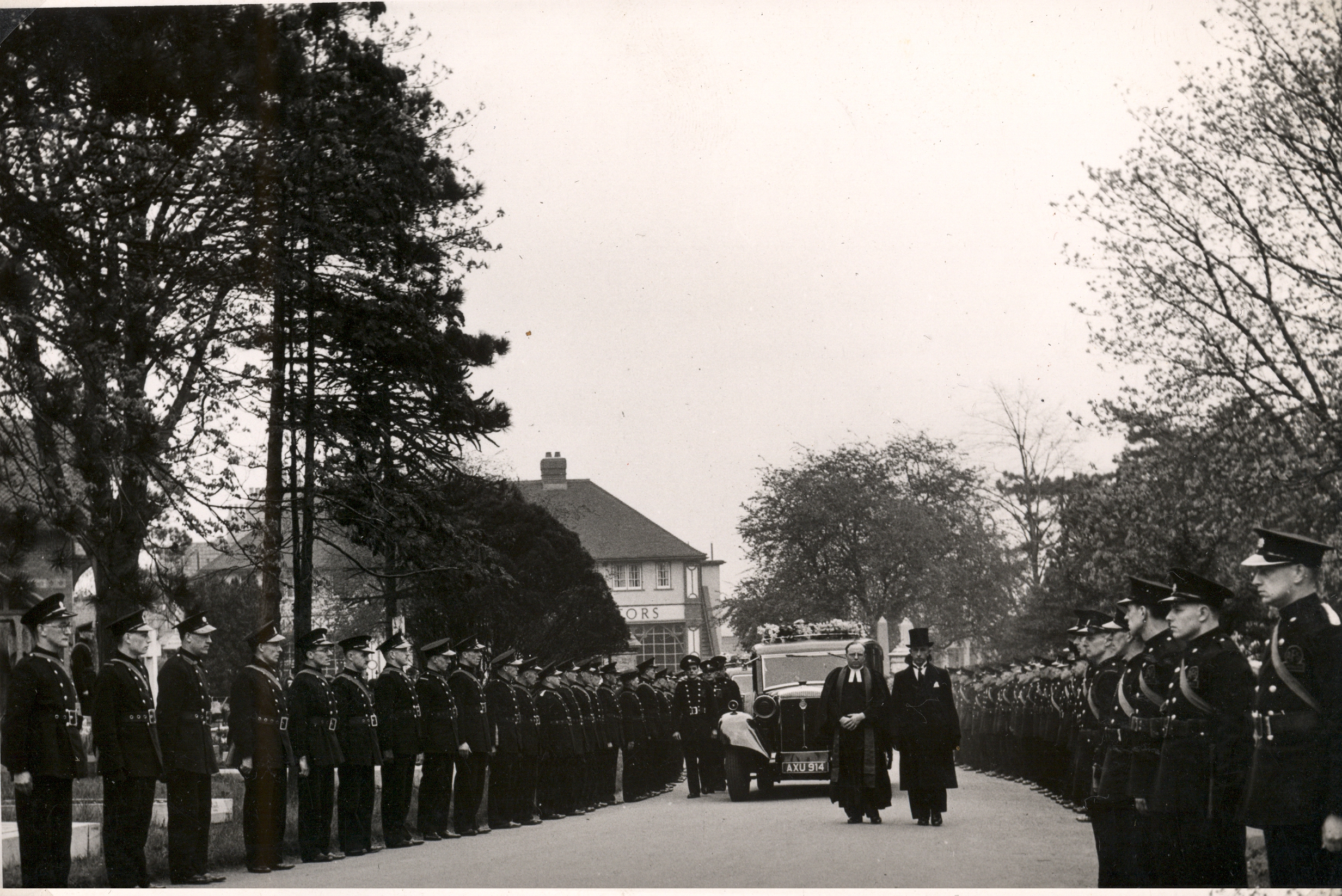
(The Funeral Cortege)
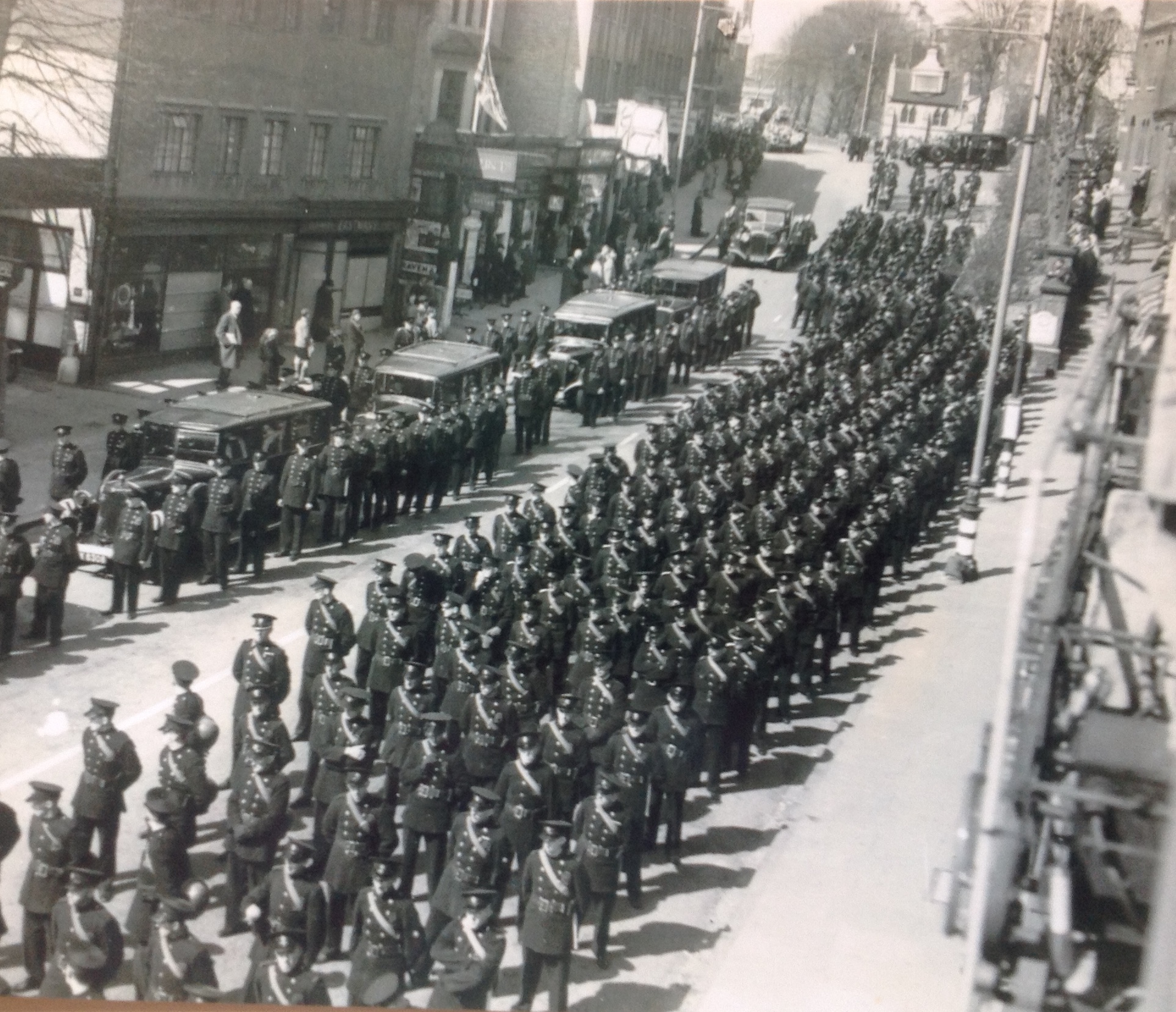
(The Funeral Cortege)
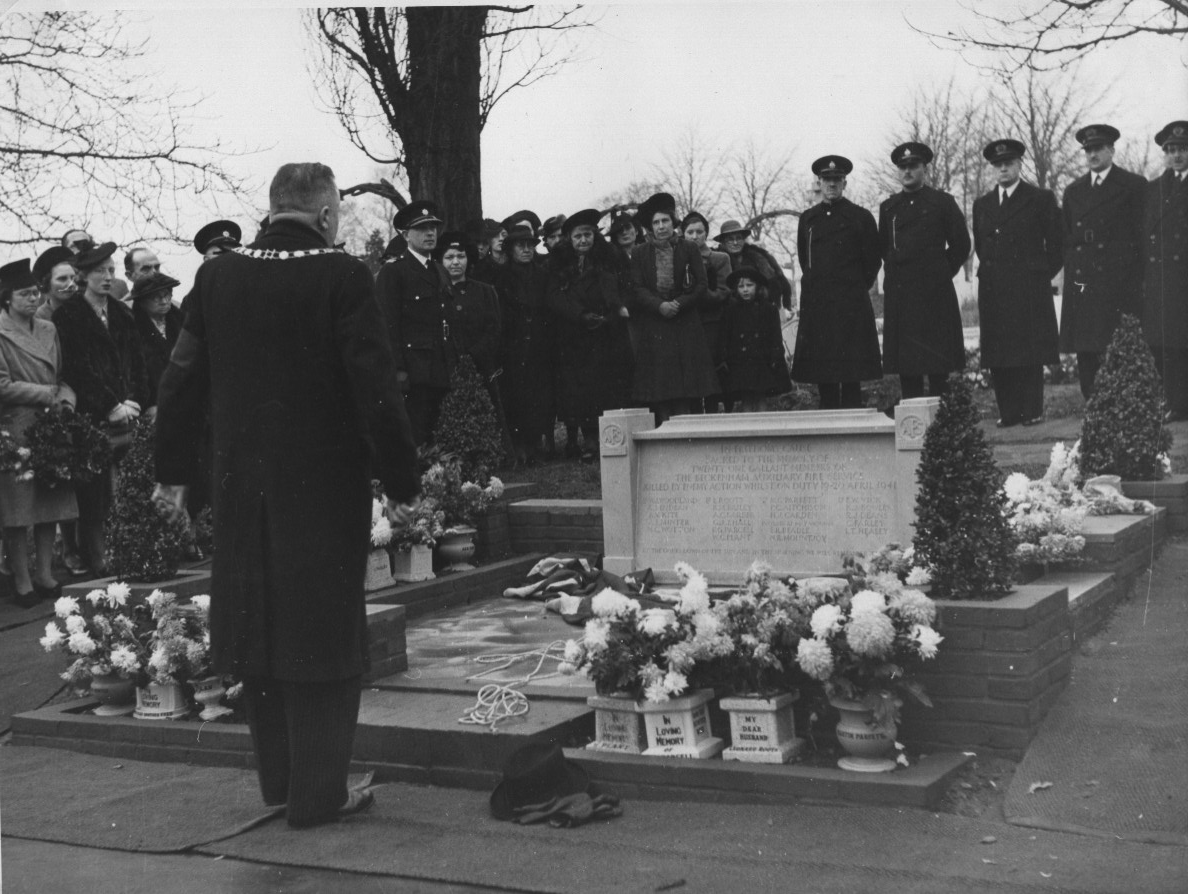
(The Unveiling of the Memorial Stone)
The grave in Beckenham cemetery is just past the car park for the crematorium on the right-hand side.
The firemen are commemorated on the memorial outside the cinema in Beckenham, which was unveiled in the fifties. Also in the fifties, much-needed council flats were built in the area and each block was named after one of the firemen. George is remembered at Hall House in Bailey Place, Sydenham, just off Newlands Park.
Recently I walked over the Millennium Bridge from Tate Modern and found a delightful monument to all London firefighters unveiled by Her Majesty, the Queen Mother, on 4 May 1991. It shows three men dramatically fighting a blaze and pointing their hose in the direction of St Paul’s Cathedral. Along the side are sculpted two firewomen, one wearing driving gloves and the other holding a pencil, recalling the work they did – often in dangerous circumstances.
The memorial stands in the pedestrian way, linking the bridge to the Cathedral and 1192 names are inscribed on it. Originally, this monument carried the names of the men and women of the fire service who died during WW2, but now it shows the names of all fire-fighters throughout the United Kingdom who have died in the line of duty.
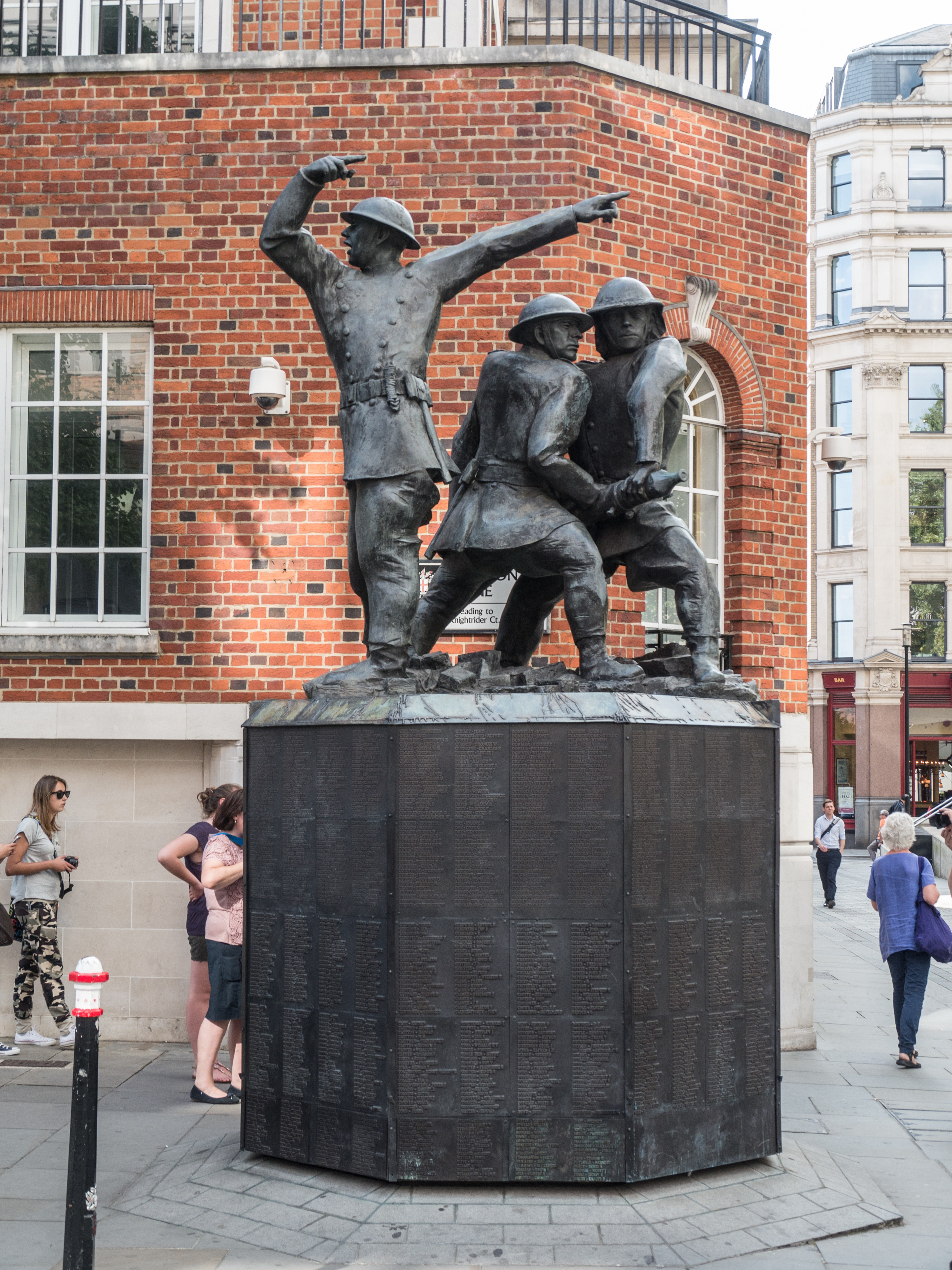
(The National Firefighters Memorial)
After the funeral, my mother simply got on with her life. AFS personnel did not have such favourable service conditions as regular firemen, so my mother did not receive a pension. She began working as an engraver (presumably on war items) at a local factory, where she eventually met my father.
Mum was not a bossy person or very superstitious, but when I married in 1971 she forbade me to save the top tier of my wedding cake for the christening because she had only been married for nine months to George and had to give hers away which must have been a heartbreaking experience.
Fifty six years after George’s death, we were invited to a dedication ceremony at the rebuilt Old Palace School St Leonards Street Poplar. One Hackney fireman did not die with his colleagues that fateful night of 20th April 1941, simply because he was on leave.
Many years later, after his death, his son, Frank, discovered his diary and realised how much the loss of his comrades had affected his father and so organised a plaque on the side of the school, clearly visible from the road.
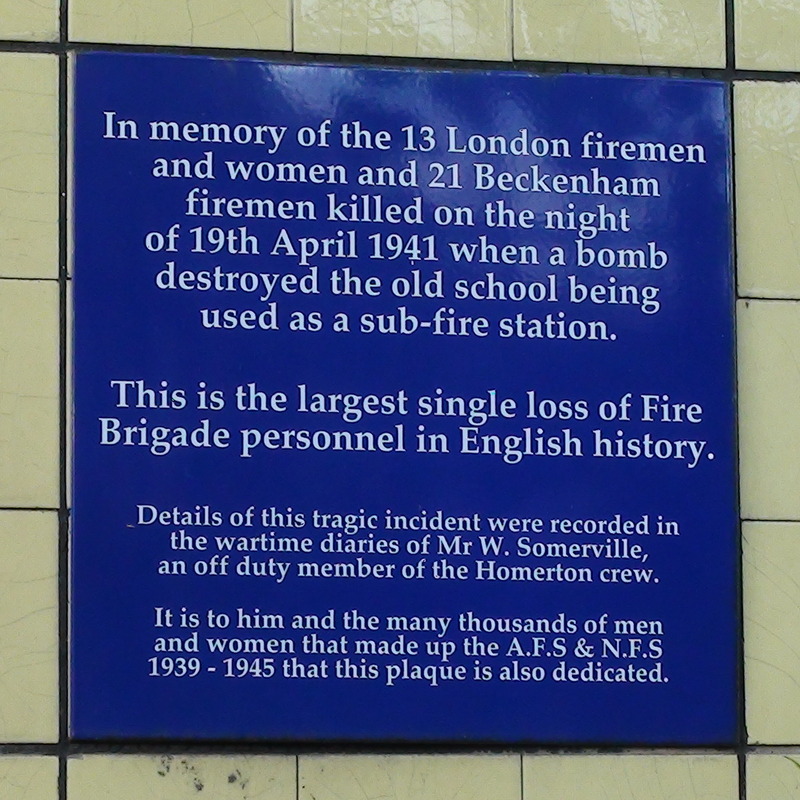
(Unveiling of the Plaque ceremony)
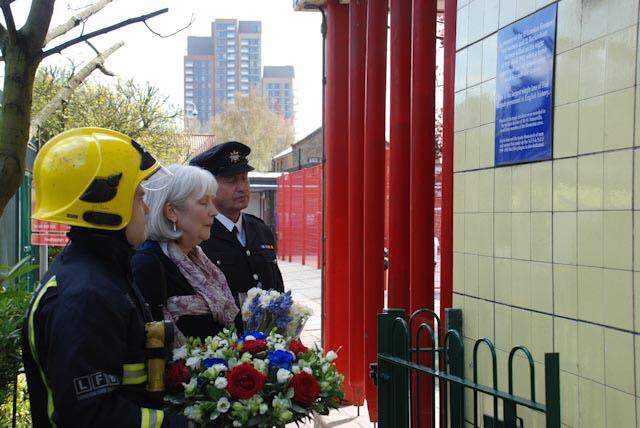
(Unveiling of the Plaque ceremony)
Mum did not want to go as it seemed unnecessary after all these years. But because I am bossy, we went and it was very interesting. They had organised old fire engines and men in the uniforms of the 1940s and neighbours had been invited, some of whom had been present on that dreadful night.
My mother died in 2002. Among her possessions was George’s watch, which had been returned to her. It was a shock to see it as it was not just smashed, but completely mangled and it really brought home to me the awfulness of the tragedy that befell those 21 Beckenham firemen. I gave the watch to his niece whom I still see occasionally.
By the time peace was announced in Europe on 8th May 1945, more than 300 fire personnel had lost their lives and ten times as many had been injured in the battle to save London. 37 firemen and one woman were awarded the George Medal and one fireman was awarded a George Cross.”
My Family History website can be found here:
https://chiddicksfamilytree.com
All My Blogs For Family Tree Magazine in one Handy Place
Copyright © 2021 Paul Chiddicks | All rights reserved



So beautifully written, Paul, and the photos are fascinating. What an amazing and sad story. May George and the other 33 that died in the Old Palace School Bombing forever rest in peace.
LikeLike
Thank you Kimberli, i hope that in the future descendants of all the 34 firefighters might find some comfort in the knowledge that their memory lives on
LikeLike
Dear Paul;
I, as a post WWII child in the USA, never really GROKKED the horror of the air raids and bombings in the U.K. Although the Fire Brigade is in some way a separate entity, the men & women of Britain who stood tall to resist and to put their lives on the line is still a sober lesson in mission, dedication, and love of country.
I will endeavor to provide the depth of information that is presented here for the fireman I am researching, but at the very least I will always have in my heart the measure of their sacrifice.
Regards,
Lorraine Schultz
LikeLiked by 1 person
Thank you so much Lorraine for your kind words and thoughts which are greatly appreciated. Also thank you so much for volunteering and helping to research one of the firemen I couldn’t do this without the kind generosity of everyone I am so fortunate to have such a wonderful band of volunteers. Thank you
LikeLike
What a wonderful tribute story to one of the brave 34! The pictures shared are really fantastic and help us to picture the scenes of destruction and the scenes of joy and commemoration!
LikeLiked by 1 person
Thank you so much Carole, please keep checking back on a regular basis as I will be adding new things on a regular basis. There are two new blogs coming this weekend!
LikeLike